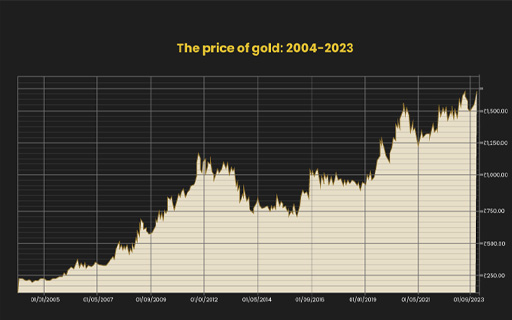2.4 Investing in commodities
A further category of investments is commodities. This is where the investment is made in assets like oil, gold and other metals or even agricultural products.
Generally there are two major attractions to these investments:
- The prices of commodities tend to rise during periods of price inflation. They consequently offer a ‘hedge’ against the risk that inflation erodes the real value of your investments.
- Commodity prices also often move in the opposite direction to other asset classes like shares and property. Indeed, during periods of weakness in equity markets investors are inclined to move to gold. As a consequence, investing in commodities can be an effective way to balance the risks on a portfolio also containing assets like shares and property.
The other side of the coin, though, is that commodity prices can be volatile and are certainly at risk of periodic sharp falls. You can see this in the chart above. In some ways, such investments have the same risk as investing in an individual share as opposed to investing in a balanced portfolio of shares.
How can investments in commodities be made? A number of options exist.
First, where practicable, the investments can be made in physical form with the commodity itself being purchased and stored. This is feasible when it comes to commodities like gold – witness the trade in gold coins. There are, though, insurance issues that need to be considered when doing this given the risk of physical loss through theft etc. Additionally, for the ordinary investor, stockpiling holdings of commodities like oil or corn will simply be impracticable.
Second, investments can be made by trading in those commodities which have an active futures market. This is investors can take positions both buying and selling future delivery of commodities in non-physical form via a financial market. If you want to add a commodity to your portfolio you can simply enter into a contract to buy it at a defined future price and, conversely, contract to sell if you are reducing your holding. Engaging in these contracts, though, does require some sophistication both in terms of understanding how futures markets operate and in being able to comply with the operational aspects of being a futures trader.
A third option is simply to buy the shares on companies whose financial performance is most related to the underlying commodity you want to invest in. So mining companies’ shares could be bought if you want to invest in defined metals; oil companies’ shares can be bought if you want to invest in oil. While this presents a straightforward way to get exposure to commodities this method of investment has weaknesses. In many cases, the financial performance of such companies and the movements in their share prices are only loosely correlated to the commodities associated with them. The performance of major oil companies, for example, is linked to an array of factors, like the taxation of petrol, which are unrelated to the price of oil.
The fourth option is, arguably, the most secure route to gaining exposure to commodities: invest in funds that track the price of a specific commodity or defined basket of commodities. This can be done by placing money into exchange traded funds (ETFs) – you’ll look more at ETF’s next week. This way of investing in commodities is reasonably simple and affords the ability to customise and risk manage your exposure to commodities.

